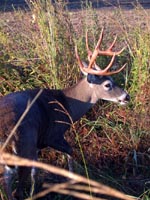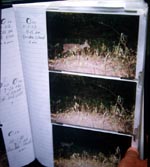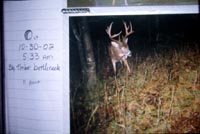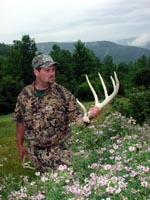
|
Features
|
|
|
|
Books
|
|
|
|
Fun & Games
|
|
|
|
Contact Us
|
|
|
John's Journal... Entry 233, Day 4
LEARN THE SECRETS OF A SHED HUNTER
Why I Use a Trail Camera
 Editor's
Note: John Frank of Rubio, Iowa, takes more trophy bucks each season than
any other hunter I know but probably kills fewer really-big bucks than
most trophy deer hunters do. Frank, the most-ardent shed hunter I've ever
met, explains that, "If I could hold a gun or a bow on a deer, and say,
'Give up your horns, and I'll let you go,' I'd probably never shoot another
buck. I'm totally fascinated with bucks' antlers and what I can learn
from them." Frank often finds big bucks that other hunters who hunt the
same property he does never see and learns more about those deer's movement
patterns than he will if he only hunts during deer season. Shed hunting
allows a deer hunter to stay in the woods and hunt without a weapon, learn
more about deer, pick up trophy antlers and become a more-proficient deer
hunter during the upcoming season. This week, John Frank will share with
us the art of shed hunting. Come back every day this week, and you may
get as excited about shed hunting as Frank.
Editor's
Note: John Frank of Rubio, Iowa, takes more trophy bucks each season than
any other hunter I know but probably kills fewer really-big bucks than
most trophy deer hunters do. Frank, the most-ardent shed hunter I've ever
met, explains that, "If I could hold a gun or a bow on a deer, and say,
'Give up your horns, and I'll let you go,' I'd probably never shoot another
buck. I'm totally fascinated with bucks' antlers and what I can learn
from them." Frank often finds big bucks that other hunters who hunt the
same property he does never see and learns more about those deer's movement
patterns than he will if he only hunts during deer season. Shed hunting
allows a deer hunter to stay in the woods and hunt without a weapon, learn
more about deer, pick up trophy antlers and become a more-proficient deer
hunter during the upcoming season. This week, John Frank will share with
us the art of shed hunting. Come back every day this week, and you may
get as excited about shed hunting as Frank.
 In
2002, Frank started using motion-sensor cameras to aid him in his shed
hunting and made some astounding discoveries. " I like the TrailMaster
camera because it's easy to operate and very user-friendly. The TrailMaster
has taught me that there are many more deer in the woods than any of us
have imagined." Frank believes that just because a hunter only sees two
or three deer while sitting in a tree stand, he may think not many deer
frequent that place. However, his TrailMaster cameras have taught him
that many deer will move through an area only at night, and some bucks
may pass through a section of land only two or three times a year.
In
2002, Frank started using motion-sensor cameras to aid him in his shed
hunting and made some astounding discoveries. " I like the TrailMaster
camera because it's easy to operate and very user-friendly. The TrailMaster
has taught me that there are many more deer in the woods than any of us
have imagined." Frank believes that just because a hunter only sees two
or three deer while sitting in a tree stand, he may think not many deer
frequent that place. However, his TrailMaster cameras have taught him
that many deer will move through an area only at night, and some bucks
may pass through a section of land only two or three times a year.
"I've photographed one huge buck on my grandparents' property and gotten three pictures of him at different times," Frank comments. "Although I know exactly where he lives, I've never seen him when I've been hunting. This buck is totally nocturnal, and the only pictures I have of him have been taken at night. But because I know where this buck lives, I can go in and hunt for his antlers after the season and take his trophy rack, even if I never take him with a gun or a bow."
 Motion-sensor
cameras enable Frank to ...
Motion-sensor
cameras enable Frank to ...
* locate more bucks before hunting season,
* find and see bucks on the property that he hunts during daylight and
nighttime hours,
* learn how many deer live on the property that he hunts-generally more
than he's estimated,
* identify the racks that the bucks carry during hunting season,
* determine if the bucks have survived hunting season,
* know where to start looking for each buck's sheds after hunting season
and
* review the photos from his camera and match the rack to the buck that
he's photographed once he finds an antler.
 Frank
also has established with his TrailMaster cameras the importance of moon
phase as it influences deer movement. "When I'm hunting deer or sheds,
I make notes as to the time of day when I spot deer moving. Then when
I get home, I check the phase of the moon to attempt to learn on what
moon phase bucks move most during daylight hours." From keeping very-detailed
notes, Frank has learned that, "Deer move the most when a moon is directly
overhead or directly under your feet. From personal observation and from
using my trail cameras, I've found that the first quarter of the moon
going into the full moon is the best time during October and November
to see big deer moving during daylight hours. I get the most photographs
of bucks at nighttime on the full moon."
Frank
also has established with his TrailMaster cameras the importance of moon
phase as it influences deer movement. "When I'm hunting deer or sheds,
I make notes as to the time of day when I spot deer moving. Then when
I get home, I check the phase of the moon to attempt to learn on what
moon phase bucks move most during daylight hours." From keeping very-detailed
notes, Frank has learned that, "Deer move the most when a moon is directly
overhead or directly under your feet. From personal observation and from
using my trail cameras, I've found that the first quarter of the moon
going into the full moon is the best time during October and November
to see big deer moving during daylight hours. I get the most photographs
of bucks at nighttime on the full moon."
TOMORROW: WHY GO ONE-ON-ONE WITH A BUCK
Check back each day this week for more about LEARN THE SECRETS OF A SHED HUNTER ...
Day 1 - How John Frank Became
a Shed Hunter
Day 2 - How John Frank Developed His Antler
Addiction
Day 3 - Where to Hunt Sheds
Day 4 - Why I Use a Trail Camera
Day 5 - Why Go One-On-One With A Buck